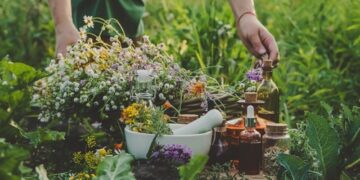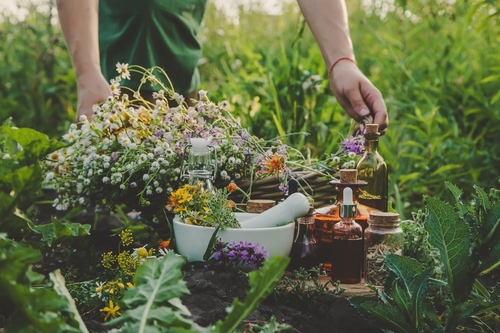Gathering with Reverence
To wildcraft is to return to an older way of knowing—a slower, more intimate rhythm in which plants are not commodities, but companions. It is the art of gathering wild herbs in a way that is respectful, careful, and rooted in deep relationship with the land. Long before store shelves and herbal apothecaries, people walked the woods and meadows to gather medicine with their own hands.
But wildcrafting is not simply foraging. It is not taking for the sake of taking. It is a conversation with the earth, built on observation, reciprocity, and restraint. When done well, it nourishes not only the body, but the land itself. When done carelessly, it can harm delicate ecosystems, endanger plant populations, and disconnect us from the very wisdom we seek.
This guide is not only about how to harvest medicinal plants from the wild—but how to do so with integrity, honoring both tradition and the living world around us.
Ad Spot #1
(Insert your first promotional element here.)
Knowing Before Gathering
Before stepping foot on a trail with basket in hand, it’s important to ask a few guiding questions. Wildcrafting is not about chasing scarcity or collecting trophies. It begins with deep knowledge—of the plants, the land, and yourself.
1. Can you identify the plant with absolute certainty?
Many plants look alike, and some have toxic or dangerous lookalikes. It’s essential to positively identify every plant before harvesting it. Use field guides, take classes, walk with experienced foragers, and never harvest if you are unsure.
2. Is the plant abundant in this area?
Only harvest from populations that are thriving. If a plant is rare, endangered, or growing in a fragile ecosystem, it must be left alone. Take note of the health of the stand—look for multiple mature plants, signs of reproduction, and resilience.
3. Are you harvesting legally and respectfully?
Always know the laws of the land. Many public lands have restrictions on foraging, and private lands require permission. Ethical wildcrafting also means respecting Indigenous territories and knowledge, and avoiding sacred or ceremonial gathering places unless invited to do so.
Harvesting with Intention
Once you’ve determined that it’s safe and appropriate to gather a plant, the act of harvesting becomes a ritual in itself. There is a way to take that does not deplete, a way to touch the earth that leaves it richer, not poorer.
Harvest only what you need.
It’s easy to get carried away when you find a patch of your favorite herb. But overharvesting—especially by multiple people in the same area—can quickly stress even the hardiest plants. Take only a small portion from each patch, and leave plenty behind for the pollinators, the soil, and the next generation.
Use a clean, sharp tool and harvest mindfully.
Avoid tearing or damaging the plant. A clean cut allows it to heal and continue growing. Take the healthiest, most vibrant leaves or flowers, and leave behind damaged or immature parts.
Offer something in return.
This can be as simple as a moment of gratitude, a song, a sprinkle of water, or a promise to tend the land in other ways. The spirit of reciprocity is at the heart of ethical wildcrafting—it transforms the act from extraction to relationship.
Common Plants to Begin With
If you’re new to wildcrafting, it’s best to begin with abundant, easy-to-identify plants that grow widely and regenerate quickly.
-
Plantain (Plantago spp.): Grows in lawns, trailsides, and disturbed soil. Its leaves are used for wound care, bug bites, and drawing out toxins.
-
Yarrow (Achillea millefolium): Found in meadows and fields; supports wound healing, digestion, and fever care.
-
Mugwort (Artemisia vulgaris): A silvery-green herb used for dreamwork and digestive support; grows abundantly along roadsides and edges.
-
Red Clover (Trifolium pratense): A gentle lymphatic and blood tonic found in sunny fields.
-
Pine Needles (Pinus spp.): Full of vitamin C, respiratory support, and immune benefit. Easily gathered with care from lower branches.
Each of these plants is generous and widespread. Learning to harvest them respectfully is a beautiful entry into deeper herbal work.
Ad Spot #2
(Insert your second promotional element here.)
When Not to Harvest
There are moments when the best act is to leave the plant untouched. A few signs to watch for:
-
The plant is growing alone or in small numbers.
-
It shows signs of disease or insect damage.
-
The land is clearly stressed—erosion, pollution, or invasive overgrowth.
-
You feel rushed, distracted, or disconnected.
Harvesting in these moments doesn’t serve you or the plant. Wait. Return another day. The right time will come, and with it, a deeper sense of trust.
Drying, Storing, and Honoring the Harvest
Once herbs are gathered, they must be treated with care to preserve their potency.
-
Drying: Lay leaves and flowers in a single layer out of direct sunlight, with good airflow. Bundles can be hung upside down if drying whole stems.
-
Storage: Keep dried herbs in glass jars, labeled with name and date. Store in a cool, dark place.
-
Use within a year when possible. Herbs fade over time—use them regularly, and let them be part of your daily rhythm.
But more than technique, honor your harvest by using it with intention. Brew teas. Make salves. Offer infusions to those in need. Let the medicine become part of your life, not just your shelf.
Tending the Wild
True wildcrafting isn’t just about taking—it’s about tending. This might mean scattering seeds, removing invasive species, or simply observing and learning from the land. Some foragers return to the same place for years, forming a relationship that’s more like stewardship than collection.
When we tend the wild, we shift from seeing it as a resource to seeing it as a relative. And in that relationship, deep healing happens—not just for us, but for the earth itself.
Closing Thoughts
To wildcraft is to remember. To re-enter an ancient agreement with the natural world, in which medicine is shared, not taken. It teaches patience, humility, and gratitude. It invites us to slow down, listen deeply, and harvest not only herbs—but wisdom.
Let every walk become a lesson. Let every leaf gathered carry a prayer. And may your wildcrafting journey be rooted in reverence, reciprocity, and deep belonging.



























